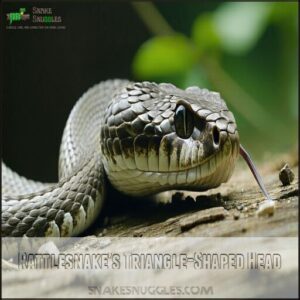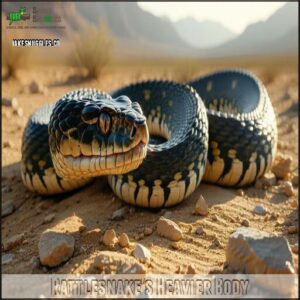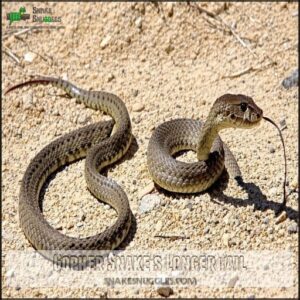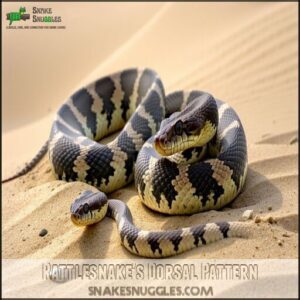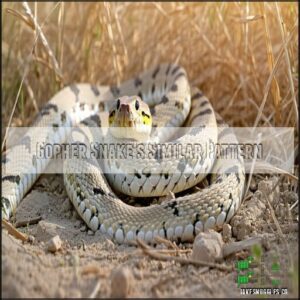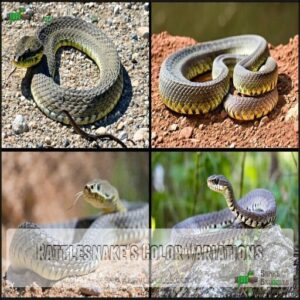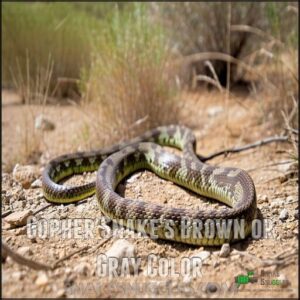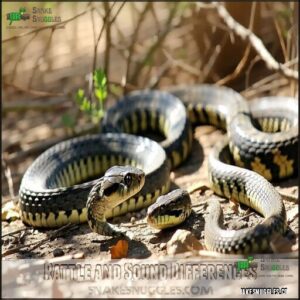This site is supported by our readers. We may earn a commission, at no cost to you, if you purchase through links.
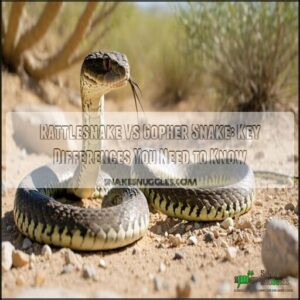 You’re trying to tell a rattlesnake from a gopher snake.
You’re trying to tell a rattlesnake from a gopher snake.
Here’s the lowdown: rattlesnakes have a distinctive rattle, triangular heads, and are venomous.
Gopher snakes, on the other hand, are non-venomous, have narrower heads, and no rattle.
When you’re out in the wild, knowing the difference between a rattlesnake vs gopher snake can be vital.
You’ll want to learn more about their habitats, behaviors, and how to identify them – and that’s just the beginning of uncovering the unique characteristics of these two snakes.
Table Of Contents
- Key Takeaways
- Body Shape Differences
- Patterns and Coloration
- Behavior and Habitat
- Rattle and Sound Differences
- Geographic Range and Distribution
- Frequently Asked Questions (FAQs)
- How do you tell the difference between a rattlesnake and a gopher snake?
- How do you tell if it’s a gopher snake?
- How can you tell if a snake is a rattlesnake?
- What rattlesnake looks like a gopher snake?
- How to tell the difference between a rattlesnake and a gopher snake?
- Do rattlesnakes avoid gopher snakes?
- Which snake is more venomous rattlesnake or cottonmouth?
- Can a gopher snake hurt you?
- Are rattlesnakes venomous?
- How do rattlesnakes hunt?
- Conclusion
Key Takeaways
- You’ll be able to tell a rattlesnake from a gopher snake by checking for a rattle, head shape, and pupils, as these are key differences between the two species.
- You can identify a gopher snake by its slender build, round pupils, and lack of a rattle, along with a more uniform color pattern and subtle markings, which are typically brown or yellowish orange.
- If you’re trying to determine if a snake is a rattlesnake, look for a triangular head, vertical pupils, and a distinctive rattle sound, as well as a heavy-set body and sharp diamond patterns, which are all characteristic of rattlesnakes.
- You should remember that while gopher snakes are non-venomous and tend to avoid biting, rattlesnakes are venomous and will use their venom to subdue prey and defend themselves, so it’s crucial to exercise caution when encountering either species.
Body Shape Differences
In terms of body shape, rattlesnakes and gopher snakes are quite distinct.
Rattlesnakes have a heavy, muscular build and a triangle-shaped head, while gopher snakes are more slender with a narrower, streamlined head.
Rattlesnake’s Triangle-Shaped Head
A rattlesnake’s triangle-shaped head is one of its clearest identifiers in any snake comparison.
The rattlesnake’s triangle-shaped head is a striking hallmark, housing venom glands that define its deadly precision and survival mastery.
This triangular advantage isn’t just aesthetic—it supports its hunting power. The broader base houses large venom glands, critical for its potent bite.
Plus, the skull structure allows for hinged fangs to deliver precise strikes. This head shape also pairs with bite force correlation, enhancing its effectiveness.
If you’re doing a snake identification, remember: that pronounced head shape, combined with its venom gland size, makes it a standout in snake differences.
Gopher Snake’s Narrower Head
Spotting the difference between a gopher snake and a rattlesnake starts with their heads.
While rattlesnakes flaunt triangular heads designed for venom storage, gopher snakes feature a slender, streamlined head.
This head shape evolution lets them burrow easily, aiding in hunting rodents underground.
The burrowing head shape also boosts their agility when chasing prey in tight spaces.
If the neck and head shape seem smooth without bold edges, you’re likely observing a gopher snake.
Rattlesnake’s Heavier Body
In the context of snake differences, the rattlesnake’s muscular build stands out.
With an average weight of 5 pounds, their body density supports quick strikes and venom delivery. Some can even tip the scale at 15 pounds! Females are often bulkier, aiding in reproduction.
This hunting advantage and strong frame also help with thermal regulation, ensuring survival in harsh environments where size truly matters.
Rattlesnakes also possess heat-sensing pit organs, which aids their survival.
Gopher Snake’s Longer Tail
A gopher snake’s longer tail stands out compared to a rattlesnake’s shorter, stubbier one.
This Tail Length Variation is key when spotting snake differences, especially during snake mimicry displays.
Gopher snakes use their tail’s muscle structure to mimic a rattlesnake’s rattle. Unlike rattlesnakes, they lack a true rattle.
Instead, they rely on agility and their tapering tail for Tail Functionality.
Here’s how gopher snake tails differ:
- Longer, slender design
- No rattle structure
- Active Tail Mimicry Defense
- Enhanced Tail Regeneration ability
- Streamlined tail for speed
Patterns and Coloration
In terms of patterns and colors, rattlesnakes and gopher snakes are easy to tell apart if you know what to look for.
Rattlesnakes often have sharp, diamond-shaped markings, while gopher snakes show softer, splotchy patterns in shades of brown or gray.
Rattlesnake’s Dorsal Pattern
When you’re trekking through nature, recognizing a rattlesnake’s dorsal pattern isn’t just interesting – it could be lifesaving.
These snake patterns boast incredible pattern camouflage, blending perfectly with their surroundings thanks to intricate scale morphology.
Here’s what to look for:
- Diamond patterns with light edges stand out beautifully against their bodies, blending into desert terrain.
- Stripe variations and chevron markings near the tail create a striking dark-to-light gradient for added concealment.
- Rich, color intensity shines through with dark brown or black blotches over gray or red backgrounds.
- Irregular crossbands, including V- or M-shapes, zigzag across their backs, scattering their outline.
These patterns aren’t just decor – they help rattlesnakes stay unnoticed while hunting or hiding. In a way, it’s nature’s own masterpiece, designed for survival.
Gopher Snake’s Similar Pattern
Gopher snakes show fascinating pattern imitation, fooling predators through mimicry evolution.
Their splotchy markings can resemble a rattlesnake, aiding in predator avoidance. Light cream, yellow, or tan backdrops highlight the dark spots along their sides, creating effective camouflage.
Regional variations in patterns make identification tricky.
| Gopher Snake Traits | Characteristics |
|---|---|
| Base Color | Cream, light brown, yellow |
| Markings | Splotchy, uneven spots |
| Belly | Light with subtle spotting |
| Pattern Confusion | Mimics rattlesnakes remarkably |
Rattlesnake’s Color Variations
Rattlesnakes boast remarkable color variations, finely tuned to their surroundings. These shades and patterns aren’t just for show—they’re a masterclass in camouflage effectiveness.
Their colors vary depending on their habitat influence:
- Deep browns with bold diamond patterns in arid zones
- Ashy grays that blend into rocky landscapes
- Olive greens for forested areas
- Reddish-browns thriving in desert climates
- Young rattlesnakes often with brighter, more vibrant hues
These changes reflect pattern development and occasional color mutations, ensuring rattlesnakes adapt perfectly for survival.
Some snake species, like the Brazilian Rainbow Boa, exhibit iridescent scale patterns. Always appreciate from a safe distance!
Gopher Snake’s Brown or Gray Color
In terms of snake coloration, gopher snakes are masters of blending in. Their bodies showcase brown hues and gray tones ranging from light tan to dark chocolate, sometimes even with a greenish tint.
This impressive color camouflage helps them avoid predators across deserts, forests, and grasslands. Regional variations in their color development make their patterns unique, including dark blotches on their backs and smaller side spots.
Here’s a quick breakdown:
| Feature | Gopher Snake | Rattlesnake |
|---|---|---|
| Color Tones | Browns, Grays, Greenish Tint | Browns, Grays, More Complex |
| Side Markings | Subtle Spots | Often Absent |
| Back Markings | Dark Blotches | Sharp Diamond Patterns |
| Camouflage | High | Moderate |
| Belly Color | Pale with Spots | Uniform Pale |
Their color genetics guarantee survival in varied terrains while aiding predator avoidance. Perfect natural design!
Behavior and Habitat
In terms of behavior, rattlesnakes rely on their rattle to warn threats, while gopher snakes mimic these movements to protect themselves.
Their habitats also differ, with rattlesnakes preferring rocky or dry areas and gopher snakes often sheltering underground or in open fields, which highlights the distinct habitats they occupy.
Rattlesnake’s Defensive Behavior
Sometimes spotting a rattlesnake means you’re already within their strike distance, but their defensive behavior isn’t about immediate attack.
Their go-to moves include:
- Freezing in place – staying perfectly still helps them stay hidden.
- Coiling posture with a tail rattle – this warning tells predators what’s coming if they don’t back off.
- Venom usage – a bite is reserved for absolute last-ditch situations.
Rattlesnakes are masters of snake warning signs, mixing patience and precision in how they handle danger, and these snakes prioritize threat assessment to avoid wasting venom.
Gopher Snake’s Mimicry Behavior
When faced with danger, gopher snakes put on a convincing performance that fools predators. Through snake mimicry, they flatten their heads, hiss loudly, and vibrate their tails against dry leaves to imitate a rattlesnake’s rattle.
Gopher snakes master the art of mimicry, hissing and tail-shaking to imitate rattlesnakes and outsmart predators with bold deception.
This clever defensive mechanism is a textbook example of behavioral ecology in action, leveraging mimicry accuracy to alter a predator’s threat perception. Gopher snakes exhibit this rattlesnake imitation when they feel threatened.
| Feature | Gopher Snake Behavior | Rattlesnake Behavior |
|---|---|---|
| Tail Movement | Vibrates against leaves | Vibrates rattle segments |
| Head Shape | Flattened, triangular | Naturally triangular |
| Sound Produced | Hissing, leaf rustling | Distinct rattle sound |
| Venomous? | No | Yes |
| Defensive Mechanism | Mimicry | Venom and rattle |
Rattlesnake’s Rocky or Dry Habitat
Beneath the scorching sun of arid climates, rattlesnakes thrive in rocky terrain and desert ecosystems.
These masters of survival use the rugged landscape to their advantage, hiding in crevices or under shrubs to ambush unsuspecting prey. Their desert adaptations include camouflage-like scales that blend seamlessly with the environment, making them nearly invisible until they strike.
Rattlesnakes are solitary by nature, often active during cooler twilight hours, a behavior known as nocturnal hunting. They rely on their potent venom delivery system to subdue prey quickly, ensuring survival in the harsh Southwestern ecosystems.
California is home to seven rattlesnake species.
- Preferred habitats: Rocky outcrops, deserts, grassy plains.
- Survival traits: Heat tolerance, excellent camouflage, and ambush tactics.
Gopher Snake’s Underground Habitat
Gopher snakes are masters of the underground ecosystem, spending most of their time in burrow systems.
Whether creating their own tunnels or taking over abandoned dens, they use these spaces for predator avoidance and temperature regulation.
Their underground habitat plays a pivotal role in their survival, especially during colder months when they hibernate.
Many owners provide a pre-made burrow alternative for their gopher snake.
Despite their ground-dwelling nature, these snakes are also agile climbers and swimmers, showcasing adaptability across their wide range.
Rattle and Sound Differences
In terms of sound, rattlesnakes and gopher snakes couldn’t be more different.
Rattlesnakes produce a distinct buzzing sound with their tail, while gopher snakes remain silent, relying on tail vibrations against surfaces to mimic their venomous counterparts.
Rattlesnake’s Rattle Sound
A rattlesnake’s rattle mechanics are a marvel of evolution.
By vibrating its tail, it produces a sharp, buzzing snake sound that’s impossible to ignore.
The sound frequency can shift from 40 to 70 hertz, creating an illusion that the predator is closer than it is.
Each hollow segment of the rattle clicks together, amplifying the effect.
- Warns predators to back off.
- Signals danger with precision.
- Mimics urgency to confuse threats.
- Highlights nature’s survival ingenuity.
Gopher Snake’s No Rattle Sound
While rattlesnakes rely on their iconic rattle, gopher snakes have mastered the art of silent communication through clever mimicry.
Without a rattle, they’ve developed unique defensive tactics to confuse predators and gain an evolutionary advantage.
- By forcefully exhaling through their glottis, they create a loud, intimidating hiss—nature’s built-in alarm system.
- Shaking their tail against dry leaves or debris, they imitate rattlesnake tail vibrations, fooling predators into second-guessing their approach.
- Some even emit a sharp "bark," a startling sound that signals danger.
This snake mimicry isn’t just for show—it’s a survival strategy. When you encounter any snake, it’s smart to respect their space and avoid testing their defenses.
Rattlesnake’s Vibrating Tail
When a rattlesnake shakes its tail, it triggers a unique warning mechanism. The sound comes from its rattle formation, made of keratin segments that interlock and click together.
These segments grow with each shed, showcasing the rattle evolution over time. Powered by strong tail muscles, the vibrations can vary in frequency depending on the snake’s urgency.
Think of it as nature’s alarm bell, signaling danger.
| Feature | Material | Purpose | Movement Type | Sound Produced |
|---|---|---|---|---|
| Rattle Formation | Keratin | Defense Signal | Vibrating | Buzzing Noise |
| Tail Muscles | Strong | Control | Rapid | Loud |
| Warning Mechanism | Audible | Predator Alert | Rhythmic | Distinct |
| Rattle Evolution | Gradual | Growth | Continuous | Increasing |
| Frequency Variation | Adjustable | Urgency Signal | Faster/Slower | Changing Pitch |
Gopher Snake’s Silent Tail
Unlike the rattlesnake’s buzzing tail, the gopher snake relies on Silent Defense.
Its tail movement mimics a rattlesnake’s Vibration Imitation by shaking against the ground or dry leaves, creating Predator Confusion.
This Tail Mimicry tricks threats into thinking it’s venomous.
However, with no rattle, it’s a quiet act—more like Ground Shaking without the noise.
If you spot a silent tail, you’re likely looking at a gopher snake, not a rattlesnake.
Geographic Range and Distribution
You’ll find rattlesnakes mainly in the western and southern United States, favoring deserts and rocky areas.
Gopher snakes, on the other hand, have a broader range, stretching from Canada to Mexico and thriving in a variety of habitats like grasslands and forests.
Rattlesnake’s Western and Southern US Range
The Western rattlesnake thrives in the western and southern U.S., adapting to deserts, mountains, and rocky terrains.
Its geographic range spans states like California, Arizona, and Texas, influenced by prey availability and climate.
These snakes are masters of desert adaptation, but human impact and conservation efforts shape their habitats.
You can find products for their range.
Their presence highlights the delicate balance between nature and development.
Gopher Snake’s Wider US and Mexico Range
The gopher snake range stretches across North America, from Canada’s forests to Mexico’s deserts.
This adaptable snake thrives in diverse habitats, including grasslands, prairies, and forests, showcasing its impressive habitat adaptability.
Found even on the Channel Islands, its geographic range overlaps with rattlesnakes but spans farther.
With a significant population density, gopher snakes play a pivotal role in pest control, highlighting their ecosystem impact and importance in conservation efforts.
They’re non-venomous snakes known for defensive mimicry tactics.
Rattlesnake’s Desert and Mountain Habitats
The rugged beauty of mountain terrain and arid desert snakes showcases how rattlesnakes adapt to extremes.
Their rattlesnake habitat thrives on elevation influence, where cooler heights aid temperature regulation, while water scarcity shapes their survival in deserts.
They blend seamlessly into rocky crevices, using camouflage needs to ambush prey.
With prey availability driving their movements, these resilient reptiles dominate sun-soaked rocks and shadowy mountain outcrops, mastering their challenging snake habitat.
Understanding their needs can be aided by exploring specific habitat products.
Gopher Snake’s Varied Habitats
Stretching from British Columbia to Mexico, gopher snakes are true masters of habitat adaptability.
Whether it’s forests, prairies, or urban parks, they thrive wherever prey availability guides them.
Their habitat diversity includes marshlands, mountain slopes, and sandy soils.
The California gopher snake and Pacific gopher snake are often spotted in overlapping environments, showcasing how climate influence shapes their range.
These burrowing experts even aid conservation efforts by controlling rodent populations in varied snake habitats.
Frequently Asked Questions (FAQs)
How do you tell the difference between a rattlesnake and a gopher snake?
You’ll encounter a million snakes, but telling them apart is key: check for a rattle, head shape, and pupils to distinguish between venomous rattlesnakes and non-venomous gopher snakes instantly.
How do you tell if it’s a gopher snake?
You’ll identify a gopher snake by its slender build, round pupils, and lack of a rattle, with a more uniform color pattern and subtle markings, typically brown or yellowish orange.
How can you tell if a snake is a rattlesnake?
You can tell if a snake is a rattlesnake by its triangular head, vertical pupils, and distinctive rattle sound, as well as its heavy-set body and sharp diamond patterns.
What rattlesnake looks like a gopher snake?
You’ll notice the Mojave rattlesnake resembles a gopher snake due to its similar color pattern and body shape, making it a common lookalike.
How to tell the difference between a rattlesnake and a gopher snake?
Like a detective, you’ll examine the snake’s body, looking for a rattle, heat-sensing pits, and distinct patterns to distinguish between a venomous rattlesnake and a harmless gopher snake quickly.
Do rattlesnakes avoid gopher snakes?
You’ll find that rattlesnakes generally avoid confrontations, including those with gopher snakes, and tend to retreat unless threatened or cornered, preferring to avoid potential dangers.
Which snake is more venomous rattlesnake or cottonmouth?
A million venomous snakes can’t be wrong – you’re safer with a gopher snake, but since it’s not an option, rattlesnakes are more venomous than cottonmouths, hands down, every time.
Can a gopher snake hurt you?
You won’t typically get hurt by a gopher snake, as they’re non-venomous and tend to avoid biting, but they may defend themselves if threatened or provoked, so handle with caution.
Are rattlesnakes venomous?
You should know that rattlesnakes are indeed venomous, using their venom to subdue prey and defend themselves, making them a potentially dangerous species to encounter in the wild.
How do rattlesnakes hunt?
You hunt by using venom to subdue prey, ambushing small mammals, birds, and reptiles, and then swallowing them whole, relying on stealth and precision to catch your next meal quickly.
Conclusion
You might think telling a rattlesnake vs gopher snake apart is tricky, but it’s easier than you think.
By knowing their key differences, you’ll be better equipped to handle encounters.
Remember, a rattlesnake vs gopher snake can be identified by their heads, patterns, and sounds, so stay alert and you’ll be just fine when dealing with a rattlesnake vs gopher snake.
- https://www.nps.gov/cabr/blogs/we-brake-for-snakes.htm
- https://wildlife.utah.gov/news/utah-wildlife-news/1202-rattlesnake-encounter-what-to-do.html
- https://baynature.org/2019/07/02/how-can-you-tell-a-gopher-snake-from-a-rattlesnake/
- https://www.desertusa.com/reptiles/rattlesnakes.html
- https://www.wilbanksreptiles.com/blogs/gopher-snake-blog/exploring-the-gopher-snakes-self-defense-tactics?srsltid=AfmBOoqdk3U%E2%80%A6

